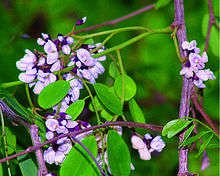Dalbergia lanceolaria
| Dalbergia lanceolaria | |
|---|---|
 | |
| Scientific classification | |
| Kingdom: | Plantae |
| (unranked): | Angiosperms |
| (unranked): | Eudicots |
| (unranked): | Rosids |
| Order: | Fabales |
| Family: | Fabaceae |
| Genus: | Dalbergia |
| Species: | D. lanceolaria |
| Binomial name | |
| Dalbergia lanceolaria L.f. | |
| Synonyms[1] | |
| |
| Wikimedia Commons has media related to Dalbergia lanceolaria. |
Dalbergia lanceolaria is a species of legume in the Fabaceae family native to India, Sri Lanka, Nepal, and Burma.[2] It is a medium-sized tree.[2] The bark of the tree is traditionally used as an analgesic and anti-diarrhoeal.[3] The apiose lanceolarin is found in its root bark.[4]
Because it produces new stems (ramets), it is recommended for reforestation projects on degraded land where seeds are unlikely to grow successfully.[5]
References
- ↑ The Plant List: A Working List of All Plant Species, retrieved 11 December 2015
- 1 2 "Dalbergia lanceolaria", India Biodiversity Portal, retrieved 11 December 2015
- ↑ Kale, M.; Misar, A.V.; Dave, V.; Joshi, M.; Mujumdar, A.M. (2007), "Anti-inflammatory activity of Dalbergia lanceolaria bark ethanol extract in mice and rats", Journal of Ethnopharmacology, 112 (2): 300–304, doi:10.1016/j.jep.2007.03.024
- ↑ Rao, P.S.; Asheervadam, Y.; Khalilullah, M.; Murti, V.V.S. (1989), "A revised structure for the isoflavone lanceolarin", Phytochemistry, 28 (3): 957–958, doi:10.1016/0031-9422(89)80157-8
- ↑ Pandey, S.K.; Shukla, R.P. (2001), "Regeneration strategy and plant diversity status in degraded sal forests" (PDF), Current Science, 81 (1): 95–102
This article is issued from Wikipedia - version of the 5/16/2016. The text is available under the Creative Commons Attribution/Share Alike but additional terms may apply for the media files.